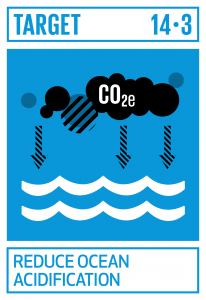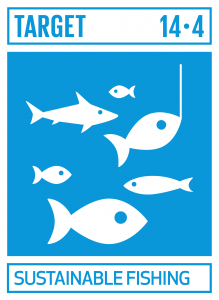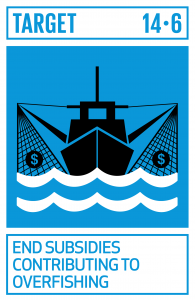Sustainable Development Goal 14 is primarily about the interactions of humans with the oceans. Specifically, it aims to conserve and manage the use of oceans, seas and marine resources for sustainable development.1 A UN General Assembly call for action has been used to clearly articulate the intentions and rationale for this goal.2 Oceans cover around 71% of the earth’s surface and regulate global weather and climate systems. These affect the livelihoods of everyone – even those living inland are affected through changing rainfall and temperature patterns. This goal recognises that oceans have environmental, economic and social benefits that extend well beyond national borders and coastal regions.3
 |  |  | |
 |  |  |  |
 |  |  |
|---|
SDG14 has 10 targets and 10 indicators. Seven of these are regular targets and include:
- reducing marine pollution (14.1)
- protecting marine and coastal ecosystems (14.2)
- addressing the impacts of ocean acidification (14.3)
- regulate ocean harvesting and ending overfishing (14.4)
- conserving at least 10% of coastal and marine areas (14.5)
- prohibiting certain types of fishing subsidies (14.6)
- increasing benefits to small island developing states and least developed countries (14.7).
There are also three other ‘means of development’ targets aimed at enabling all countries to have the resources to meet the goals which are described below.4
Transition from the MDG targets to SDG 14 in Cambodia
During the earlier Millennium Development Goals, the only MDG target related to human interactions with the oceans was target 7.B, relating to the reduction of biodiversity losses. More specifically relevant were indicator 7.4, measuring the proportion of fish stocks within safe biological limits and indicator 7.6, measuring the proportion of marine (and terrestrial) areas protected in the country.5 For the Cambodian Millennium Development Goals (CMDGs), indicator 7.4 – a global indicator focused only on marine fisheries – was not monitored at the country level.6 There were also significant capacity gaps limiting the development of a marine protected area.7
As a result, the MDGs were modified. Cambodia has one the lowest proportions (24%) of people living within 100km of a coastline in the Mekong Region except for the landlocked Lao PDR.8 Because of the Mekong River, the Tonle Sap Lake and River and extensive floodplains in Cambodia, inland fisheries have much more significant production than ocean resources.9
However, production from inland fisheries was declining due to overfishing so reforms were needed. Therefore the localised CMDGs aimed to:
- increase the number of all fishing lots (marine and inland) available to local communities (from 56 to 60% – in CMDG 7.6)
- more than double the number of community-based fisheries (from 264 to 589 – CMDG 7.7)
- more than double the area of surface fish sanctuaries (from 264,500 to 580,800 ha – CMDG 7.8).10
Graph comparing inland fisheries production to Marine Fisheries Production 11
Private fishing lots were abolished in the Tonle Sap in 2012,12 516 community fisheries were established (475 inland and 41 marine)13 and in 2010, at 466,000 hectares, Cambodia at was well on-track to meeting planned sanctuary area.14
The focus of the SDG targets goes beyond a focus on biological diversity to consider the range of ways humans interact with oceans. This includes direct impacts of coastal and marine resources from habitat destruction or over fishing and indirect impacts such as plastic pollution from upstream inland rivers and higher levels of CO2 emissions leading to ocean acidification. It also aims to improve the equitable distribution of marine and coastal resources.15
While the Cambodian Sustainable Development Goals (CSDGs) are not expected to be released until mid-2018,16 there are indications that the Royal Government of Cambodia will expand its focus to include them. For example, in 2016 the Ministry of Agriculture Forestry and Fisheries signed a prakas declaring a 405 Km2 Marine Fisheries Management Area (MFMA) around the islands of Koh Rong and Koh Rong Sanloem, near Preak Sihanouk.17

Panoramic image of Koh Rong Sanloem’s west coast, shot from the lighthouse in the south of the island, Cambodia. Photo by Wikirictor, taken in 2014. Licensed under CC BY-SA 4.0
Localization of SDG 14 in Cambodia
A rapid integrated assessment was conducted on a broad range of Cambodia’s national policy documents to assess how ready the country was to implement the SDGs. For SDG14, this included documents such as:
- National Strategic Development Plan (NSDP) 2014–201818
- National Biodiversity and Strategy and Action Plan 2016, which has a specific theme (theme 10) relating to the monitoring and protection of Cambodia’s 435 km of coastline and 500,000 km2 marine Exclusive Economic Zone (EEZ)19
- National Strategy Plan on Green Growth (2013–2020), which has a focus on Blue Economy Development and Sustainability20
- other related sector plans.21
In the assessment, all SDG14 targets were found to be addressed through national policy documents, except for target 14.6. In the NSPD (2014–2018) there is only a broad statement relating to the phasing out or reform of subsidies for water use in the agricultural sector but there is no specific mention of removing subsidies that contribute to overfishing. The assessment suggests that because of this, target 14.6 is only partially addressed in Cambodia’s plans.22 When SDG14 is integrated into the next NSPD 2019–2023, this should be addressed. It is also highly likely that we will see inland fisheries again being monitored as an important localisation of the SDGs.
SDG14 has been described as having a cross-cutting role in implementing the Sustainable Development Agenda as a whole. Taking action to meet SDG14 targets is likely to help meet other goals, particularly for least development countries, such as Cambodia and for small island developing states.23 A UN study has recommended that each country should consider how SDG14 is linked with SDGs 1, 2, 3, 8, 9, 12, 13, 15 and 16 in particular – these are believed to have the strongest connections.24
Means of implementation for SDG 14 in Cambodia
The three ‘means of implementation’ indicators for’ SDG14 all offer opportunities to improve the relationship of Cambodian citizens with marine and coastal resources, allowing greater benefits from sustainable development.
For example:
- SDG target 14.A, is about increasing scientific knowledge research capacity and how technology transfer has the potential to significantly improve how Cambodia benefits from its ocean resources. While it is clear the scale of marine fisheries has continued to increase rapidly since the 1990s, there is little reliable data about actual production volumes of marine fisheries and how much they benefit the economy. There are claims that up to 25% of marine fish production in Cambodian waters does not reach the nation’s shores. 25 The Gulf of Thailand Large Marine Ecosystem (LME) area, which borders Malaysia, Thailand, Cambodia, and Vietnam, has been classified by the Transboundary Waters Assessment Program as having a very high level of overall risk, with a low Ocean Health Index score.26 ‘Blue economy’ initiatives described in regional and national ‘State of the Ocean and Coasts’ reports supported by technical assistance will be required by Cambodia as a least developed country to both meet the SDGs, respond the the risks and develop the national economy.27
Map of Cambodia showing coastal and marine territories in the Gulf of Thailand
- SDG target 14.B, aimed at providing access for small-scale fishers to marine resources and markets, is highly relevant in Cambodia, where the majority of small-scale fishers are poor and their operations unprofitable. The activities of coastal fishers are largely unmonitored and minimal data exists to support initiatives to improve their sustainability. Many small-scale fishers lack the capacity to access target catches and rely on bycatch, which produces low levels of income and has an negative impact on marine ecosystems.28
- SDG target 14.C, which aims to enhance the conservation and sustainable use of oceans and their resources through international law, may motivate Cambodia to ratify the United Nations Convention on the Law of the Sea (UNCLOS), which it is already a signatory to. This could enable Cambodia to access formal legal mechanisms to address issues such as illegal, unreported and unregulated (IUU) fishing in its EEZ, without affecting the country’s national interests.29
Monitoring SDG 14 in Cambodia
When the UN was developing the targets and indicators for SDG14 it made a deliberate decision not to pay too much attention to the data already available. It decided instead to focus on what it wanted to achieve from the goals, even if the information was not yet available. As a result, 80% of the indicators for SDG14 were still not available in 2017, compared to only 58% for all SDG indicators combined.30
At the same time, the process the government is using to decide on how Cambodia will adapt the Sustainable Development Agenda to develop the CSDGs has still not been finalized. This will involve localising targets and indicators in a way that still enables Cambodia’s progress to be compared regionally and globally.31. The CSDGs will then be integrated to align closely with the new National Strategic Development Plan (2019–2023) when it is released in 2019.32
In mid-2016, at the global-scale, SDG14 was the only goal with no publicly available data. Open-source data is now available for SDG indicator 14.5 (coverage of protected areas in relation to marine areas).There is still likely to be improvements in the way this indicator is monitored.33
Indicator 14.4.1, regarding the proportion of fish stocks within safe biological limits, has been available only at the global scale. While more data is now available,34 it is likely to stay at this scale until problems with fish migration, technical capacity and political sensitivity related to ocean boundaries are resolved.35
This means it is likely that Cambodia will need to cooperate regionally to address marine overfishing and with upstream Mekong countries to address inland overfishing. Another global indicator, indicator 14.3, looks at ocean acidification. This is mainly caused mainly by CO2 emissions, which cannot be contained within national borders. All other indicators in terms of Cambodia and SDG 14 require further clarification before data can be shared for public monitoring of the goal’s progress. This will happen over time as work on the SDGs at all levels progresses.36
Related Topics
References
- 1. UN Sustainable Development Knowledge Platform, “2017 HLPF Thematic review of SDG14: Conserve and sustainably use the oceans, seas and marine resources for sustainable development.” Accessed on 11 June 2018.
- 2. UN General Assembly 2017, “Our ocean, our future: call for action.” Accessed on 11 June 2018.
- 3. UN Sustainable Development Knowledge Platform, “2017 HLPF Thematic review of SDG14: Conserve and sustainably use the oceans, seas and marine resources for sustainable development.” Accessed on 11 June 2018.
- 4. United Nations Sustainable Development Knowledge Platform , “Sustainable Development Goal 14: Conserve and sustainably use ocean, seas, and marine resources for sustainable development.” Accessed on 11 June 2018.
- 5. United Nations International Children’s Emergency Fund (Unicef), “Millennium Development Goals (MDG) monitoring.” Accessed on 11 June 2018.
- 6. Luara Recuero Virto, “Issue Paper: A preliminary assessment of indicators for SDG 14 on ‘Oceans’,” Organisation for Economic Co-operation and Development (OECD), November 2017. Accessed on 11 June 2018.
- 7. Boon P.Y., Mulligan, B., Benbow, S.L.P., Thorne, B.V., Leng P. & Longhurst, K. “Zoning Cambodia’s fi rst Marine Fisheries Management Area,” Cambodian Journal of Natural History (2014), 55–65. Accessed on 11 June 2018.
- 8. Partnerships in Environmental Management for the Seas of East Asia (PEMSEA),”Sustainable Development Strategy for the Seas of East Asia (SDS-SEA),” (Quezon City, Philippines, PEMSEA, 2015). Accessed on 11 June 2018.
- 9. Baan, E. and G. Gallego, “Cambodia’s fisheries: a decade of changes and evolution,” Catch and Culture (2015), 21(3): 30-33. Accessed on 11 June 2018.
- 10. Ministry of Planning (MoP), “Annual Progress Report: Achieving the Millennium Development Goals,” Phnom Penh, December 2013. Accessed on 11 June 2018.
- 11. Ministry of Agriculture, Forestry and Fisheries (MAFF), “Annual report on status of agriculture, forestry and fisheries in 2017 and further action plan,” Phnom Penh, January 2018. Accessed on 11 June 2018.
- 12. International Union for Conservation of Nature (IUCN), “Fisheries conservation and governance in the Tonle Sap”. Accessed on 11 June 2018.
- 13. Ministry of Agriculture Forestry and Fisheries (MAFF). “Annual Report for Agriculture, Forestry and Fisheries 2016-2017 and Direction 2017-2018,” MAFF Conference, April 2017. Accessed on 12 June 2018.
- 14. Royal Government of Cambodia (RGC). “The Fifth National Report to the Convention on Biological Diversity,” 2014. Accessed on 12 June 2018.
- 15. United Nations Sustainable Development Knowledge Platform. “Sustainable Development Goal 14: Conserve and sustainably use ocean, seas, and marine resources for sustainable development”. Accessed on 12 June 2018.
- 16. Sovandy, P. “SDG Localization into Cambodian Context: Progress, M&E Framework and Next Step,” presentation prepared for the Technical Working Group (TWG) Retreat 2017, (Phnom Penh, February 2017). Accessed on 12 June 2018.
- 17. Fauna & Flora International, “Joint press release: Cambodia’s first large-scale marine protected area declared for Koh Rong Archipelago”, 2016. Accessed on 12 June 2018.
- 18. Royal Government of Cambodia (RGC), “National Strategic Development Plan (2014–2018)”, Phnom Penh, July 2014. Accessed on 12 June 2018.
- 19. National Council for Sustainable Development (NCSD), “National Biodiversity Strategy and Action Plan 2016”, February 2016. Accessed on 12 June 2018.
- 20. National Council on Green Growth (NCGG), “National Strategy Plan on Green Growth (2013-2020)”, February 216. Accessed on 12 June 2018.
- 21. United Nations of Development Programme (UNDP), “Rapid Integrated Assessment – Cambodia SDG Profile,” (United Nation in Cambodia). Accessed on 12 June 2018.
- 22. United Nations of Development Programme (UNDP). “Rapid Integrated Assessment – Cambodia SDG Scorecard Profile,”(United Nation in Cambodia). Accessed on 12 June 2018.
- 23. UN Sustainable Development Knowledge Platform, “2017 HLPF Thematic review of SDG14: Conserve and sustainably use the oceans, seas and marine resources for sustainable development.” Accessed on 12 June 2018.
- 24. Le Blanc, D., C. Friere & M. Vierros, “Mapping the linkages between oceans and other Sustainable Development Goals: A preliminary exploration,” Department of Economic and Social Affairs of United Nation Working Paper No.149, February 2017. Accessed 12 June 2018.
- 25. UNIDO, FiA & MAFF,. “Environmental Impacts Assessment of Marine Fisheries Related Activities in Cambodia,” report prepared for Royal Government of Cambodia, 30 September 2015. Accessed 12 June 2018.
- 26. Transboundary Water Assessment Programme (TWAP) Data Portal. “LME 35 – Gulf of Thailand,” One Shared Ocean, 2015. Accessed 12 June 2018.
- 27. Corazon, M. and M. Ebarvia. “Regional and National State of Oceans and Coasts Reports,” presentation prepared for the Blue Economy Forum 2017. Accessed on 12 June 2018.
- 28. UNIDO, FiA & MAFF,. “Environmental Impacts Assessment of Marine Fisheries Related Activities in Cambodia,” report prepared for Royal Government of Cambodia, 30 September 2015. Accessed on 12 June 2018.
- 29. Sotharith, C. “Maritime Security in Cambodia: A Critical Assessment,” Cambodian Institute for Cooperation and Peace (CICP) Working Paper No.21, November 2007. Accessed on 12 June 2018.
- 30. Luara Recuero Virto, “Issue Paper: A preliminary assessment of indicators for SDG 14 on ‘Oceans’,” Organisation for Economic Co-operation and Development (OECD), November 2017. Accessed on 12 June 2018.
- 31. Sovandy, P. “SDG Localization into Cambodian Context: Progress, M&E Framework and Next Step,” presentation prepared for the Technical Working Group (TWG) Retreat 2017, (Phnom Penh, February 2017). Accessed on 12 June 2018.
- 32. Sovandy, P. “SDG Localization into Cambodian Context and Financing for Implementation,” Incheon, Republic of Korea, 31 October 2017. Accessed on 12 June 2018.
- 33. United Nations. “Sustainable Development Goals Metadata Repository.” Accessed on 12 June 2018.
- 34. Ibid.
- 35. Luara Recuero Virto, “Issue Paper: A preliminary assessment of indicators for SDG 14 on ‘Oceans’,” Organisation for Economic Co-operation and Development (OECD), November 2017. Accessed on 12 June 2018.
- 36. Ibid.

